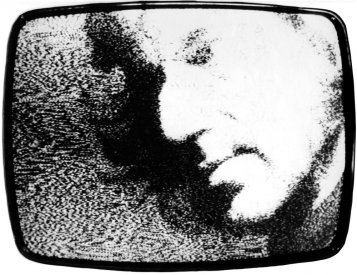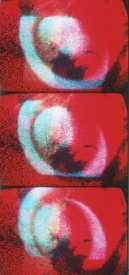The Cantrills might be said to have invented Expanded Cinema (at least in Australia) – in which the production and particularly the projection of films is not seen as a single screen form but one in which all kinds of things, from manipulation of the colour during the processing of the film to the use of several projectors and screens, coupled with performance, poetry, music and the stage are take as the medium in which the visual information can be supported and displayed.
Arthur Cantrill was born in Sydney in 1938. He originally studied Electrical Engineering but abandoned it in favour of puppetry, which followed into making films for children about puppetry.
Corinne Cantrill was born in 1928. She studied botany through an interest in the Australian bush. Heavily involved in Sydney's cultural life during the 1940s, after WWII she went to London in 1948, then Paris, Rome and Copenhagen, working as freelance journalist and teaching English. She returned to Sydney in 1953, moved to Brisbane in 1956 and established Children's Creative Leisure Centres in Queensland. She met Arthur during the period in Brsibane.
Their early films were short documentaries on children's creative activities, followed by story series for children shown on the ABC (1961-63). At the same time Arthur worked as a film editor for the ABC in Brisbane, and they were both members of the Brisbane Cinema Group which was already showing the New American Cinema films by people like Jonas Mekas.1
From the beginning we set the early pattern for our future working practice: two film workers sharing all the filming tasks; avoiding costly “professional” procedures, using resourcefulness and knowledge of the medium to avoid waste and cost. Much of our early work was centred at home, often involving our two small children as subjects. From the start we maintained our independence from sponsors and all funding bodies: we made only the films that interested us...2
The ABC films included several environmental and landscape films. These were followed by a series of films on Robert Klippel's sculptures (1964) and three films based on fireworks imagery, which led the Cantrills to an interest in the abstract potentials of film. They also began a series of films in which the artist subject was able to speak directly to the audience through the film, including Harry Hooton and Skin of Your Eye (Seen).
They moved to London in 1965, where again they focused on the cultural life rather than making films. However Arthur again worked as a film editor and together they honed their technical skills including editing and the production of complex sound tracks. At this time they discovered avant-garde film from Europe and America and this added to their interest in abstract film-making using animation and in-camera superimposition. Their “work in sound composition reached its peak [at this time] with complex organic and electronically achieved sounds.”3
Then in 1969 they returned to Australia to take up a Creative Art Fellowship at the Australian National University (ANU) in Canberra. The main product of this fellowship was the film celebrating the life and poetry of Harry Hooton, who had been a great influence on the Cantrills with his definition of art as “the application of emotion to matter.” As they note: “The materiality of film has always been important to us; pushing into different physical and chemical possibilities.”4
It was during the period of the ANU fellowship that they began the exploration of the ideas that led to their multi-screen, Expanded Cinema work. After the fellowship they moved to Melbourne and in February 1971 began a series of expanded cinema screenings, called Living Cinema, on Sunday evenings at the Maze, a music venue. During this period they also made Video Selfportrait, described as “A [6-min] videographic film exploiting the phosphor textures on the cathode screen. Video images are filmed, filter-coloured and supered in the camera.”5
In March 1971 they began to publish Cantrills Filmnotes.
After a year or so in Melbourne they went overseas again and lived America from 1973 to 1975, teaching at Penn State University, and showing their work in America and Canada including Charlotte Moorman's Avant-Garde Festival in New York, where they showed Moving Statics in the first year, and in the next year, “a very elaborate multi-screen work called Skin of Your Eye (Seen), about the Melbourne counterculture.”6
The main emphasis of their work has been and is on the filmic examination of themes such as landscape, colour, light, and the history and technology of film.7 The multi-screen works and subsequent landscape films make up the 150 films in the Cantrills' oeuvre. In many ways the work they put into Cantrills Filmnotes had a major influence on young and experimental film and video makers for the many years of its publishing. (All issues of the magazine are still available from the Cantrills.)
In 1985 they received a DAAD grant which allowed them to work in Berlin, Germany, for several months, during which they had a retrospective at the Arsenal Cinema. More recently (June 2011) they have had an exhibition of the artefacts of the production and exhibition of their film works – Arthur and Corinne Cantrill: Light Years8 – at the Australian Centre for the Moving Image (ACMI), along with the showing of a selection of their films.
- 1. Millie Stein: Interview with Corinne and Arthur Cantrill available at http://www.theblackmail.com.au/issue/art/moving-statics/
- 2. Arthur and Corinne Cantrill, “An Annotated Auto-Filmography” in Kiffy Rubbo, Judy Annear (eds) Mid-Stream: A Survey Exhibition of the Filmwork by Arthur and Corinne Cantrill, 1963-1979, Melbourne: Ewing and George Paton Galleries (1979), 5.
- 3. Ibid, 6.
- 4. Millie Stein: Interview with Corinne and Arthur Cantrill available at http://www.theblackmail.com.au/issue/art/moving-statics/
- 5. BFI Film and TV Database: http://ftvdb.bfi.org.uk/sift/title/387512
- 6. Millie Stein: Interview with Corinne and Arthur Cantrill available at http://www.theblackmail.com.au/issue/art/moving-statics/
- 7. May 2011, arsenal cinema. 50 Years of Film: Corinne and Arthur Cantrill: http://www.arsenal-berlin.de/en/arsenal-cinema/past-programs/single/article/1921/2804//archive/2010/may.html
- 8. http://www.acmi.net.au/lightyears.aspx
Filmography (16mm unless otherwise noted)
FILM MADE BETWEEN 1960-1963
A series of children's art and craft films made for ABC TV; The Odyssey: series of 10, 10 min, episodes with shadow puppets; Kip and David: series of 13, 12 min episodes; Zoo, 30 min. Several 5 min. silent 'interludes' made for ABC TV, eg Tower of Blocks, Feeding the Ducks, Pebbles etc. A Sereis of four 6 min. studies of native flora: Banksia Serrata, Banksia Integrifolia, Pandanus Pedunculatus, Casuarina Equisetifolia.
Mud, 4 mins, 1963
Galaxy, 4 mins, 1963
Nebulae, 4 mins, 1963
Kinegraffiti, 4 mins, 1963
Robert Klippel Sculpture Studies, 5 films, each 5 mins, 1964-1965
Robert Klippel Drawings: 1947-1963, 25 mins, 1965
The Incised Image, 25 mins, 1966
Dream, 4 mins, 1966
Adventure Playground, London, 6 mins, 1966
Henri Gaudier-Brzeska, 30 mins, 1968
Red Stone Dancer, 6 mins, 1968
Moving Statics, 28 mins, 1965
Rehearsal at the Arts Laboratory, 4 mins, 1969
Imprints, 4 mins, 1969
Fud 69, 6 mins, 1969
Home Movie - A Day in the Bush, 4 mins, 1969
Eikon, 3 1/2 mins, 1969
White-Orange-Green, 4 mins, 1969
Bouddi, 8 mins, 1970
4000 Frames, An Eye-Opener Film, 3 mins, 1970
Earth Message, 23 mins, 1970
Harry Hooton, 83 mins, 1970
New Movements Generate New Thoughts, 11 mins, 1971
The Boiling Electric Jug Film, 8 mins, 1971
Blast, 6 mins, 1971
Meditations, 6 mins, 1971
Nine Image Film, 3 mins, 1971
Zap, 2 mins, 1971
Video Self-Portrait, 6 mins, 1971
Gold Fugue, 3 mins, 1971*
Pink Metronome, 3 mins, 1971*
Room, 5 mins, 1971*
The City, 8 mins, 1971*
Fragments, 13 mins, 1971*
Island Fuse, 11 mins, 1971
Skin of Your Eye, 117 mins, 1973
At Eltham, 24 mins, 1974
Reflections on Three Images by Baldwin Spencer, 1901, 17 mins, 1974
Negative/Positive on Three Images by Baldwin Spencer, 1901, 10 mins, 1975
Three Colour Separation Studies - Landscapes, 13 mins, 1976**
Three COlour Separation Studies - Still Lifes, 13 mins, 1976**
Simple Observations of a Solar Eclipse, 16 mins, 1976
Touching the Earth series:
1 - Ocean at Point Lookout, 46 mins, 1977
2 - Near Coober Pedy, 15 mins, 1977
3 - At Uluru, 80 mins, 1977
3 - Katatjuta, 24 mins, 1977
Moving Picture Postcards, 16 mins, 1978**
Heat Shimmer, 13 mins, 197888
Hillside at Chauritchi, 6 mins, 1978
Near Wilmington, 6 mins, 1978
Meteor Crater, Grosse Bluff, 6 mins, 1978*
Ocean, 15 mins, 1978*
Interior/Exterior, 3 mins, 1978**
Printer Light Play, 6 mins, 1978
Angophora and Sandstone, 15 mins, 1979**
Coast at Pearl Beach, 11 mins, 1979*
Notes on the Passage of Time, 14 mins, 1979**
Grain of the Voice Series:
1 - Rock Wallaby and Blackbird, 66 mins, 1980
2 - Two Women, 32 mins, 1980
3 - Seven Sisters, 19 mins, 1980
Unthurqua, 6 mins, 1980
Warrah, 15 mins, 1980**
Experiments in Three-Colour Separation, 21 mins, 1980**
Two-Colour Separation Studies, 16 mins, 1980
Pan/Colour Separations, 11 mins, 1980*
The Second Journey (To Uluru), 74 mins, 1981
Wilpena, 23 mins, 1981
Time/Colour Separations, 18 mins, 1981**
Floterian - Hand Printings From a Film History, 12 mins, 35mm and 16mm, 1981
Corporeal, 18 mins, 1983***
Passage, 65 mins, 1983***
At Black Range, 12 mins, 1984
Waterfall, 18 mins, 1984**
In This Life's Body, 147 mins, 1984
Notes on Berlin, the Divided City, 30 mins, Super 8mm, 1986
Walking Track, 20 mins, Super 8mm, 1987
The Berlin Apartment, 120 mins, 1987*** (new version 1992)
Myself When Fourteen, 19 mins, 1989 (with Ivor Cantrill)
Ball Film, 32 mins, Super 8mm, 1990
Agung Gives Ivor a Haircut, 4:30 mins, Super 8mm, 1991
The Bemused Tourist, from Bogor to Bandung, 23 mins, Super 8mm, 1992
View From the Balcony of the Mrco Polo Hotel, 4 mins, Super 8mm, 1992/ rev.1993
Rendra's Place, Depok, 8 mins, Super 8mm, 1992
Walking to Yeh Pelu, 10 mins, Super 8mm, 1993
The Pause Between Frames, 4 mins, Super 8mm, 1993
In the Shadow of Gunung Batur, 8 mins, Super 8mm, 1993
Ming-Wie to Singaraja, 7:30 mins, Super 8mm, 1993
Ivor's Tiger Xmas Card, 7:18 mins, Super 8mm, 1994
Ivor's Exhibition, 15 mins, Super 8mm, 1995
Ramayana/Legong, 5 mins, Super 8mm, 1995
Jalan Raya, Ubud, 15 mins, Super 8mm, 1995
Early Morning at Borobudur, 20 mins, Super 8mm, 1995
* 3-screen film
** 3-colour separation film
*** 2-screen film
FILM/PERFORMANCE WORKS
Expanded Cinema 1970-1972 (Included multiscreen, projection onto patterned and 3-D screens, and onto burning screens and screens of water. Also included following two works.)
Calligraphy Contest for the New Year 1971 (Hand-painted film projected anamorphically onto black screen progressively painted white and cut into patterns by Aurthur Cantrill.)
Concert for Electric Jugs 1971 (Film of boiling electric jug projected onto four boiling electric jugs.)
Edges of Meaning 1977 (Film images by Walter Baldwin Spencer on two screens at right angles, installation of Spencer frame enlargements, Corinne Catrill reading from Spencer's writing.)
Fields of Vision 1978 (3-screen projection of extracts from Cantrill landscape films, with commentary live and recorded by A. & C. Cantrill, installation of film stills.)
Grain of Voice 1980 (Films made with Pitjantjatjara song men and women with live commentary and action by C. and A. Cantrill; installation of sand, trees, Aboriginal artifacts; film stills.)
Passage 1983 (2-screen film of journey from Melbourne to Central Australia with live and recorded commentary and action by C. and A. Cantrill; installation of sand, trees, tent, garments, camera; film stills.)
Journey Through a Face 1984 (Autobiographical film with live and recorded commentary and action by Corinne Cantrill, installation of photographs, flowers, garments.)
The Berlin Apartment 1986 (new version 1992) (2-screen film of filmmakers living in a Berlin apartment with live commentary and action by Corinne Cantrill, installation of furnishings, flowers.)
Projected Light 1988 (2-screen and alides of film about filmmakers house and film history and live and recorded commentary by A. and C. Cantrill, on cinema as art of projected light.)







